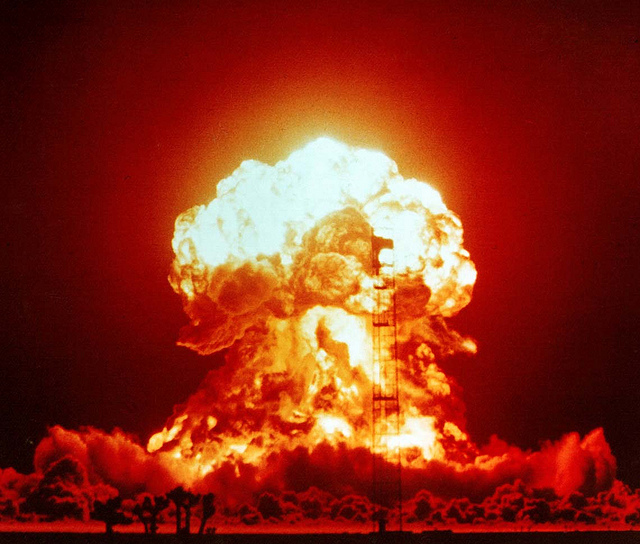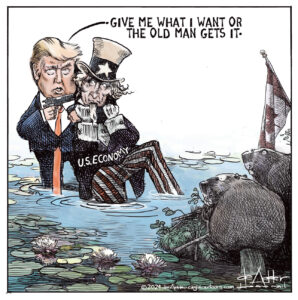One Minute to Midnight
The world is on the edge of a catastrophe, but the U.S. is whistling blithely down the path of nuclear destruction it has helped to pave. The Official CTBTO Photostream / Flickr
The Official CTBTO Photostream / Flickr
Late last month, the Bulletin of the Atomic Scientists unveiled its “Doomsday Clock” for the 26th time since its creation in 1947, declaring that the hands on the clock would remain where they had been at the last setting, in 2018. Rachel Bronson, the bulletin’s president, described the environment in which the bulletin assesses the threats faced by the world today (which have expanded beyond nuclear to include climate change and cyber) as the “new abnormal,” and noted that no one should take comfort from the fact that the hands of the clock have not moved.
“This new abnormal,” Bronson wrote in her statement explaining the decision, “is a pernicious and dangerous departure from the time when the United States sought a leadership role in designing and supporting global agreements that advanced a safer and healthier planet. The new abnormal describes a moment in which fact is becoming indistinguishable from fiction, undermining our very abilities to develop and apply solutions to the big problems of our time.”
William Perry, former secretary of defense under President Bill Clinton, helped unveil the 2019 iteration of the Doomsday Clock. In his remarks, he highlighted President Donald Trump’s declaration to withdraw from the landmark 1987 Intermediate-Range Nuclear Forces (INF) Treaty as an indication of the collapsing relationship between the U.S. and Russia. “When you withdraw from treaties, you are losing this important vehicle of dialogue,” Perry observed. “My own judgment is, relative to a year ago, we are slightly worse off.”
I agree with Perry—the world is worse off today than it was a year ago. I disagree, however, with his use of the word “slightly” to describe the situation we face, and I dissent from the bulletin’s decision to stay the hands of the Doomsday Clock. Humanity is sleepwalking toward global annihilation, furthered by a collective amnesia about the threat posed by nuclear weapons, especially in an environment void of meaningful arms control. On Feb. 2, the United States suspended its obligations under the INF Treaty, beginning a 180-day process that, once concluded, will lead to the abandonment of that agreement. Russia soon followed suit. The death of the INF Treaty represents far more than simply the end of an era. It is the end of a process—a mindset—that recognized nuclear weapons for their globe-killing reality and sought their reduction and eventual elimination.
The danger of nuclear weapons has always been at the center of the Doomsday Clock. According to its mission statement, the Bulletin of the Atomic Scientists was founded in 1945 by Manhattan Project scientists who “could not remain aloof to the consequences of their work.” Two years later, in 1947, the bulletin unveiled its iconic clock, the hands of which were ominously set to seven minutes before midnight. “The Bulletin’s clock,” the late Eugene Rabinowitch, one of the bulletin’s founding editors, noted, “is not a gauge to register the ups and downs of the international power struggle; it is intended to reflect basic changes in the level of continuous danger in which mankind lives in the nuclear age, and will continue living, until society adjusts its basic attitudes and institutions.”
In 1953, the Soviet Union acquired the hydrogen bomb. That act, on the back of the Korean War, caused the bulletin to ruminate about the unrestrained development of nuclear weapons and the lack of any meaningful arms control efforts to hold nuclear proliferation in check, and prompted it to move the hands of the Doomsday Clock to two minutes before midnight.
Since then, the hands of the Doomsday Clock have been moved back and forth on numerous occasions; retreats were due largely to arms control efforts undertaken by the major nuclear powers and advances due to the failures of these efforts to achieve any lasting change. At the height of the Cold War, in 1984, with the U.S. and the Soviet Union locked in a massive arms race, the Doomsday Clock’s hands were moved to three minutes past midnight; in 1988, in recognition of the INF Treaty, the hands were moved back to six minutes, then further to 10 minutes in 1990, marking the end of the Cold War, and to 17 minutes in 1994, on the occasion of the Strategic Arms Reduction Treaty (START). The common denominator in this retrograde movement (which, in the context of the meaning of “midnight,” is a good thing) was the embrace of meaningful arms control and the calming effect it had on relationships between nations.
Within three years, the optimism that prompted the bulletin to move the hands of the Doomsday Clock back began to falter; the failure of the U.S. and Russia to conclude the START 3 treaty and the expansion of NATO moved the hands to 14 minutes in 1994, while the nuclear tests conducted by India and Pakistan in 1998 caused the bulletin to advance a further five minutes, to nine minutes (its largest forward move since 1968, when nuclear tests by France and China produced a similar result). The demise of the Anti-Ballistic Missile (ABM) Treaty in 2002 moved the hands to seven; the failure of the nonproliferation treaty in the context of North Korea and Iran pushed them to five in 2007. The election of President Barack Obama injected rare optimism at the bulletin, which moved the hands of the clock back to six minutes in 2010. But his administration’s failure to ratify the Comprehensive Test Ban Treaty in 2014 brought the hands back to five minutes, and the election of Donald Trump caused the hands to be moved to 2.5 minutes. The failure of the U.S. and Russia to return to the arms control negotiating table brought the hands to their current position in 2018—two minutes before midnight.
The demise of the INF Treaty is symptomatic of a larger problem—the collapse of arms control as an institution. Viktor Mizin, one of the Soviet negotiators involved in the INF Treaty, made note of this reality, and its consequences. “[Soviet arms control negotiators] got their start with the first negotiations for the partial test-ban treaties [in the 1950s]. These were the people with whom the partial [U.S.-Soviet] detente and the idea of peaceful coexistence began … [t]his was an entire generation of brilliant diplomats, soldiers, and defense industry specialists. It’s no coincidence that most competent people around then were the ones who participated in all these negotiations … [w]e don’t have anyone like them now. Both here and in America, there’s been a collapse of institutional memory, and no one remembers what happened at these negotiations, and there’s nobody who has the same negotiating skills.” Worse, Mizin noted, “We’re absolutely failing to raise the next generation.”
The INF Treaty grew out of an idea—“double zero”—put forward in 1982 by President Reagan in a speech at his alma mater, Eureka College. The ideas presented in the speech were the brainchild of Richard Perle, the archconservative assistant secretary of defense for global strategic affairs. The crux of the proposition made by Reagan was that the Soviet Union would eliminate the totality of its SS-20 intermediate-range missile force. The SS-20 was a new road-mobile missile armed with three 750-kiloton nuclear warheads, and its deployment in 1976 was seen by the U.S. and NATO as a game-changer. In exchange for the Soviets agreeing to eliminate these weapons, the U.S. would forego the deployment of two missiles—the Pershing II and the Ground Launched Cruise Missile—that were still under development. In short, the U.S. position was that the Soviet Union would get rid of more than 1,400 missiles, while the U.S. got rid of nothing. That proposal, according to Thomas Graham, a senior U.S. arms control official at the time, “was seen as impossible and ridiculous.”
Converting the “impossible and ridiculous” into reality was the job of a team of negotiators led by two experienced U.S. diplomats—Paul Nitze and Maynard Glitman. Nitze, best known as the architect of America’s Cold War policy of containment of the Soviet Union, was a member of the first Strategic Arms Limitation Treaty (SALT I) delegation, considered the most distinguished negotiating delegation the U.S. has ever fielded. This experience served him well during his tenure as chief INF negotiator. In an effort to break the impasse created by the American “Zero Option” position, Nitze undertook his now famous “walk in the woods” with his Soviet counterpart, Yuliy Kvitinsky, where the two, on their own, agreed to a disarmament formula that would reduce the threat posed by the INF systems. Reagan was initially supportive of Nitze’s proposal but backtracked when Richard Perle vehemently objected. “The trouble with you,” Perle told Nitze afterward, “is you are just an inveterate problem solver.”
In 1983, the Soviets walked out of the INF talks, frustrated at the lack of progress being made. Three years later, after the ascension of Mikhail Gorbachev as leader of the Soviet Union, the talks resumed, this time led by Glitman, who had been Nitze’s deputy during the first round of talks from 1981 to 1983. Glitman proved a steady, sobering presence, and by the end of 1987 had negotiated a treaty that saw the elimination of all U.S. and Soviet INF weapons—a true “Zero Option” (Perle, who opposed the INF Treaty, resigned in protest).
The INF Treaty has gone through its fair share of trials and tribulations. As one of the first U.S. inspectors assigned to monitor the Votkinsk missile plant in the Soviet Union, where SS-20 missiles had been assembled, I was involved in helping turn back the efforts of such conservative lawmakers as Sen. Jesse Helms, who sought to use delays in the implementation of inspection procedures at Votkinsk as an excuse to kill the treaty. That these delays were brought on by shortcomings on the American side were of no moment to Helms and his allies. Fortunately, sober minds prevailed, and the inspections were conducted in total conformity with the treaty.
The 2002 decision by the U.S. to withdraw from another foundational arms control agreement—the ABM Treaty—stoked frustration inside Russia over what it viewed as the unbalanced nature of the INF Treaty, which prohibited its possession of intermediate-range missiles while the U.S. expanded NATO and fielded missile defense systems in Europe, and other nations, such as China, India and Pakistan, were allowed to develop INF-capable systems without restriction. Russian President Vladimir Putin gave voice to these concerns in 2007, saying, “We need other international participants to assume the same obligations which have been assumed by the Russian Federation and the US.”
The next year, U.S. intelligence observed a missile test in Russia that it assessed as a violation of the INF range limitations. Additional tests were observed, which led the Obama administration, in 2014, to report Russia to Congress as being in violation of the INF Treaty. Russia vehemently denied these allegations and demanded that the U.S. provide it with the evidence the allegations were derived from, something the U.S. has refused to do. A series of accusations and counteraccusations followed, culminating in the U.S. identifying the offending missile system—the 9M729—and demanding that Russia come into compliance.
There is a solution to be had—the INF Treaty provides for the existence of the Special Verification Commission (SVC) for the express purpose of resolving disputes that may arise during the life of the treaty. The SVC has been engaged on this issue, but the refusal of the U.S. to back up its claims of noncompliance with evidence, and the repeated denials by Russia that it has violated the INF Treaty, have made diplomacy difficult. The primary problem, however, isn’t the technical aspects of any controversy over treaty compliance—as a veteran of several such controversies, I can attest that they can be resolved to mutual satisfaction, provided both parties are committed to the process. The issue today is that the U.S. no longer has in its diplomatic arsenal arms control negotiators of the caliber of Nitze or Glitman. These men have passed, and, as Mizin laments, no effort has been undertaken to groom their successors.
The last serving American expert on arms control, Thomas Countryman, was unceremoniously fired by Trump shortly after he took office. I knew Countryman from when he was the U.S. mission in New York’s liaison to the United Nations Special Commission on Iraq. By the time of his firing, Countryman was charged with negotiating, implementing and verifying international arms control agreements. “The world doesn’t stop turning just because there is a new U.S. administration,” Joseph Cirincione, president of the Ploughshares Fund, observed in the aftermath of Countryman’s firing. “There is an entire global arms regime to maintain. Without U.S. leadership, decisions won’t get made or will get taken in ways that harm our national security.”
The woman appointed to fill Countryman’s role as chief arms negotiator, Andrea Thompson, is a 25-year veteran of the Army who specialized in intelligence but had no arms control background. She came to the White House in 2017 from the McChrystal Group Leadership Institute, an advisory organization formed by retired Gen. Stanley McChrystal, for whom Thompson worked in both Iraq and Afghanistan. At the White House, Thompson served as the deputy assistant to the president and national security adviser to the vice president, positions that emphasize political loyalty over subject matter expertise.
During his 2019 State of the Union address, Trump outlined the position he has taken regarding the INF Treaty. “Under my administration,” he declared, “we will never apologize for advancing America’s interests. For example, decades ago the United States entered into a treaty with Russia in which we agreed to limit and reduce our missile capability. While we followed the agreement to the letter, Russia repeatedly violated its terms. It’s been going on for many years. That is why I announced that the United States is officially withdrawing from the Intermediate-Range Nuclear Forces Treaty, or INF Treaty. We really have no choice.”
There was a choice—meaningful negotiations—but Thompson is no Nitze, and her approach toward arms control negotiations was counterproductive. She met with her Russian counterparts in Geneva in January in a last-ditch effort to save the INF Treaty. “I outlined that to my Russian counterparts on specifically what Russia would need to do in order to return to compliance in a manner the United States could confirm,” Thompson said in a press briefing after the meeting. “And at the end of the day, this includes the verifiable destruction of Russia’s noncompliant missile system.”
The Russians, Thompson noted, “paid lip service to transparency. They offered a briefing and demonstration, a static demonstration, of its noncompliant missile system. They continued to dodge questions. They continued to push false information regarding the missile’s capabilities and the testing activity. For example, a demonstration that Russia can’t possibly address the fact that they previously tested the missile, again I reiterate, they previously tested this missile to Treaty-prohibited ranges.”
The physical inspection of missiles has always been a part of arms control agreements. The Russians did put the 9M729 missile on display after Thompson’s briefing, inviting military attaches to inspect it and its launcher. The U.S. refused to attend and pressured its European allies to likewise boycott the demonstration. A videotape of the event backed up the Russian claim that the 9M729 was little more than an improved version of an INF Treaty-compliant missile, the 9M728, making use of the exact same solid fuel motor. While the static display alone would not be enough to mollify U.S. concerns, it would have been a giant step toward reaching a resolution of the U.S. allegations.
But Thompson wasn’t looking for resolution. She was looking for capitulation. “As the undersecretary for arms control and international security and a leader within this administration,” she said at her briefing, “for arms control to serve its purpose, violations must have consequences. And as I told Russian counterparts yesterday, Russia faces a choice: It can either have its noncompliant missile system, or it can have the INF Treaty. But it cannot have both.”
Foreign Minister Sergei Lavrov has declared that Russia tested the 9M729 missile at the range allowed under the INF Treaty, and that the U.S. has provided no proof of the alleged violation. “Only last fall, [the United States] named two dates when, according to their estimates, tests that violated the INF Treaty took place. We explained to them that the tests had indeed taken place, but the range was allowed by the treaty. We asked them to provide some concrete proof of the range violation, such as satellite pictures or something else, but have not received anything,” Lavrov said at a news conference.
That the pending demise of the INF Treaty hasn’t sent shockwaves around the world is, in and of itself, disturbing. The casual reaction on the part of Congress and America’s NATO allies to what is, in effect, the end of arms control is alarming. It is one thing for Congress and NATO to accept without question the unsustained contention on the part of both the Obama and Trump administrations about Russian INF Treaty violations—European relations with Moscow have been strained since the 2014 annexation of the Crimea, and Russia-bashing has been in vogue in the U.S. since the intelligence community’s allegations of Russian meddling in the 2016 presidential election were published in January 2017.
But the termination of the INF Treaty is part and parcel of the total unwinding of the last remaining vestiges of U.S.-Russian arms control—the New START treaty, which caps the number and type of strategic nuclear weapons delivery systems that can be deployed by both parties. New START expires in 2021, and the unceremonious approach Thompson has taken toward resolving INF Treaty compliance issues has detrimentally affected any chance of an extension to that treaty being negotiated before it expires. “The environment isn’t in a place where I can discuss the New START treaty,” Thompson said at her INF press conference. For his part, Lavrov observed, “The entire architecture of arms control, including the New START, including the prospects for further nuclear disarmament and the sustainability of the nonproliferation treaty, is in jeopardy.”
The Russians have always feared American intermediate-range missiles based in Europe. The Cuban missile crisis of 1962 was driven in large part by the Russian need to respond to the threat posed by the presence of U.S. Jupiter missiles based in Turkey. And the INF Treaty was signed largely because of Russian concerns over the American Pershing II missile, which could strike Moscow in seven minutes or less after being launched from Germany, eliminating any possibility of Moscow being able to determine whether a notification of missile launch was real or false. Moreover, Russia’s nuclear posture—launch on detection (meaning Russia would fire its missiles once a nuclear attack had been verified)—would need to be altered to “launch on warning” or, worse, “pre-emptive nuclear attack.” The desire to avoid creating the conditions for a nuclear holocaust drove the Soviet Union to sign the INF Treaty in 1987. “The INF treaty was put there in the first place to stop there being a nuclear strike with very little warning time,” British security expert Annie Machon has observed. “And that was a step forward at the time—that it is being torn up now is very worrying.”
The U.S. nuclear posture review published by the Trump administration has postulated specific scenarios in which nuclear weapons could be used—including against Russia in Europe. With the INF Treaty gone, and the caps on strategic nuclear weapons soon to be eliminated due to the expected demise of the New START treaty, there is real concern that the U.S. and Russia are about to enter into a nuclear arms race that would rival that of the U.S. and Soviet Union in the 1980s. The difference this time is that neither side has a stable of seasoned arms control experts working on the sidelines to avoid catastrophe. Instead, led by the likes of Andrea Thompson, the U.S. is whistling blithely while sauntering down the path of nuclear destruction.
Thompson would do well to digest the words of Putin during a presentation of the Valdai Discussion Club last October. Confronted with a scenario involving an American nuclear attack, he noted that “the aggressor must know that retribution is inevitable, that it will be destroyed.” The Russian president did not mince words when it came to recognizing the consequences of any Russian nuclear retaliation. “We are victims of aggression, as martyrs we will go to heaven,” Putin told the audience. “And they will just die.”
The Bulletin of the Atomic Scientists is wrong to keep the hands of the Doomsday Clock stuck at two minutes to midnight. The situation is far more grave than its assessed “new abnormal” would suggest. The United States is in the process of creating the conditions for a nuclear war with Russia, and the Russian president is calmly talking about global annihilation if such an event transpires.
The world is on the edge of the nuclear abyss. It’s one minute before midnight, and we are acting as if we still have time. We don’t.
Your support is crucial...As we navigate an uncertain 2025, with a new administration questioning press freedoms, the risks are clear: our ability to report freely is under threat.
Your tax-deductible donation enables us to dig deeper, delivering fearless investigative reporting and analysis that exposes the reality beneath the headlines — without compromise.
Now is the time to take action. Stand with our courageous journalists. Donate today to protect a free press, uphold democracy and uncover the stories that need to be told.






You need to be a supporter to comment.
There are currently no responses to this article.
Be the first to respond.